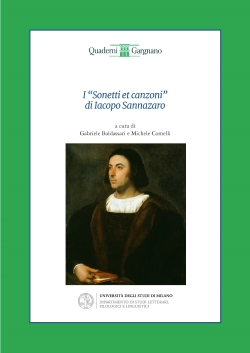
Pubblicato 11.11.2020
Parole chiave
- Sannazaro,
- Sonetti et canzoni,
- canzoniere
Abstract
As the title indicates, the paper once again deals with the difficult problem of Sannazaro's lyrics, which are read divided into two parts in the posthumous edition of 1530. An important essay by Dionisotti, in 1963, has well explained that the division is not modeled in any way on that which runs through the Canzoniere of Petrarch, and, on the other hand, argues that strictly speaking it is not even a division, since only the second part would have the character of a songbook, while the first would collect in a disorganized way a series of scattered texts. In spite of the repeated contrary opinion of Rosangela Fanara, who has dedicated many studies to the question, the thesis of Dionisotti has generally imposed itself, even if with some variation of tone more than of substance, and also this intervention, after a re-examination of the problem, ends up by making it its own. The new element that we would like to add consists in underlining that the theme of love remains fragmentary, disjointed, incapable of founding a unitary event endowed with an ordering force, even if in the second part there is some attempt in this sense. But the letter with which Sannazaro entrusts his poems to Cassandra Marchese so that she can choose the ones worthy of surviving, shows that the end of the Aragonese season has destroyed every possible unitary project, if there ever was one, and that the fragments and the tables left afloat (to use Sannazaro's own metaphor) give evidence not of the organism of which they should have been part, but of its irremediable shipwreck.
Come il titolo dice, l’intervento affronta ancora una volta il difficile problema delle rime di Sannazaro, che si leggono divise in due parti nella postuma edizione del 1530. Un importante saggio di Dionisotti, del 1963, ha ben spiegato che la divisione non si modella in alcun modo su quella che attraversa il Canzoniere di Petrarca, e per contro sostiene che a rigore non si tratta neppure di una divisione, dato che solo la seconda parte avrebbe andamento di canzoniere, mentre la prima raccoglierebbe in maniera disorganica una serie di testi sparsi. Nonostante il reiterato giudizio contrario di Rosangela Fanara, che ha dedicato molti studi alla questione, la tesi di Dionisotti si è generalmente imposta, seppur con qualche variante di tono più che di sostanza, e anche questo intervento, dopo un riesame del problema, finisce per farla propria. L’elemento nuovo che si vorrebbe aggiungere consiste nel sottolineare che il tema amoroso resta frammentario, disgregato, incapace di fondare una vicenda unitaria e dotata di forza ordinatrice, anche se nella seconda parte si trova qualche tentativo in questo senso. Ma la lettera con la quale Sannazaro affida a Cassandra Marchese le proprie rime perché a suo insindacabile giudizio scelga quelle meritevoli di sopravvivere mostra che la fine della stagione aragonese ha distrutto ogni possibile progetto unitario, ammesso che ce ne sia mai stato uno, e che i frammenti e le tavole rimaste a galla (per usare la metafora di Sannazaro medesimo) danno testimonianza non già dell’organismo del quale avrebbero dovuto far parte, ma del suo irrimediabile naufragio.
